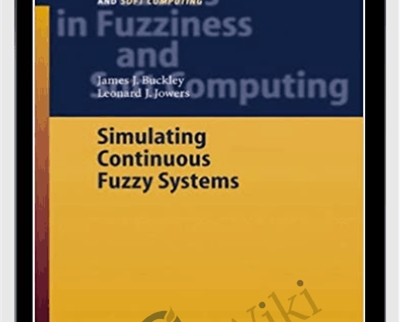Achieve more with the Simulating Continuous Fuzzy Systems – James Buckley course, priced at just Original price was: $117.69.$21.00Current price is: $21.00. on GBESY.biz! Explore our extensive collection of over 60,000 downloadable courses in Business and Sales. We offer professional, self-paced digital education at up to 80% off original rates. Start transforming your expertise now!
Salepage link: At HERE. Archive:
$117.69 $26 – Simulating Continuous Fuzzy Systems – James Buckley
1. 1 Introduction This book is written in two major parts. The ?rst part includes the int- ductory chapters consisting of Chapters 1 through 6. In part two, Chapters 7-26, we present the applications. This book continues our research into simulating fuzzy systems. We started with investigating simulating discrete event fuzzy systems ([7],[13],[14]). These systems can usually be described as queuing networks. Items (transactions) arrive at various points in the s- tem and go into a queue waiting for service. The service stations, preceded by a queue, are connected forming a network of queues and service, until the transaction ?nally exits the system. Examples considered included – chine shops, emergency rooms, project networks, bus routes, etc. Analysis of all of these systems depends on parameters like arrival rates and service rates. These parameters are usually estimated from historical data. These estimators are generally point estimators. The point estimators are put into the model to compute system descriptors like mean time an item spends in the system, or the expected number of transactions leaving the system per unit time. We argued that these point estimators contain uncertainty not shown in the calculations. Our estimators of these parameters become fuzzy numbers, constructed by placing a set of con?dence intervals one on top of another. Using fuzzy number parameters in the model makes it into a fuzzy system. The system descriptors we want (time in system, number leaving per unit time) will be fuzzy numbers.
$117.69 $26 – Simulating Continuous Fuzzy Systems – James Buckley
Invest in endless knowledge with the Simulating Continuous Fuzzy Systems – James Buckley course at GBESY.biz! Gain lifetime access to premium digital content designed to fuel your professional and personal growth.
- Lifetime Access: Unrestricted, permanent access to your purchased courses.
- Unbeatable Value: Save significantly with prices up to 80% less than direct purchases.
- Protected Payments: Complete your transactions securely.
- Empowering Skills: Learn practical, in-demand skills for immediate application.
- Immediate Download: Access your course content instantly after purchase.
- Any Device, Anywhere: Study on your preferred device with full flexibility.
Discover your next opportunity with GBESY.biz!
![GBesy [GB] GBesy [GB]](https://gbesy.biz/wp-content/uploads/2023/05/gbesy-Logo-full-100.png)
![GBesy [GB] GBesy [GB]](https://www.gbesy.com/wp-content/uploads/2023/05/gbesy-Logo-full-100.png)



 Purchase this course you will earn
Purchase this course you will earn 





Reviews
There are no reviews yet.